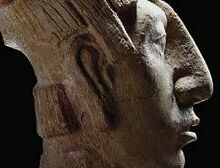 Art & Culture Art & Culture
Carl Hartman
A queen pulls a thorn-studded rope through her tongue. A king who ruled more than 60 years appears in a handsome bust. Ball players wear heavy padding for protection from an eight-pound solid rubber ball - a loss can bring death.
These are some of the 1,500-year-old sculptures in the biggest show put together in this country of Mayan art from Mexico and Central America, which opens Sunday at the National Gallery of Art in Washington D.C.
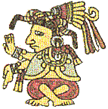 Courtly Art of the Ancient Maya, the
first exhibition ever devoted to this subject in the United States, will
demonstrate the visual magnificence of ancient Maya art with over 130
masterworks drawn from the some 30 public and private lenders in Mexico,
Honduras, Guatemala, Chile, the United States, Switzerland, England, and
Australia. The exhibition will present stone sculptures, ceramics, masks, and
other precious works commissioned by ancient Maya kings and queens. In a period
of just 200 years from AD 600-800, Maya kings and nobles, while living in the
tropical rain forests of southern Mexico and adjacent Guatemala, Honduras, and
Belize, transformed Maya art, achieving a peak of dramatic expression and
naturalism unmatched in the ancient New World. Using examples from the ancient
Maya cities of Palenque, Tonina, Yaxchilan, and Bonampak, among others,
Courtly Art of the Ancient Maya will examine political and religious
power in the royal court, which served as the central force in the life of each
city. Courtly Art of the Ancient Maya, the
first exhibition ever devoted to this subject in the United States, will
demonstrate the visual magnificence of ancient Maya art with over 130
masterworks drawn from the some 30 public and private lenders in Mexico,
Honduras, Guatemala, Chile, the United States, Switzerland, England, and
Australia. The exhibition will present stone sculptures, ceramics, masks, and
other precious works commissioned by ancient Maya kings and queens. In a period
of just 200 years from AD 600-800, Maya kings and nobles, while living in the
tropical rain forests of southern Mexico and adjacent Guatemala, Honduras, and
Belize, transformed Maya art, achieving a peak of dramatic expression and
naturalism unmatched in the ancient New World. Using examples from the ancient
Maya cities of Palenque, Tonina, Yaxchilan, and Bonampak, among others,
Courtly Art of the Ancient Maya will examine political and religious
power in the royal court, which served as the central force in the life of each
city. |
Lady Xok, the queen, is on her knees performing an ancient Mayan ritual. The
year is A.D. 709. Blood flows from her mouth to her cheeks and drops on bits of
paper in a basket. Her husband, King Shield Jaguar, holds a burning spear to
light the ceremony.
In the figures, carved in profile above the door in the queen's palace, the
bloody paper is burned as a sacrifice to the gods. Lady Xok is rewarded for her
sacrifice with a vision.
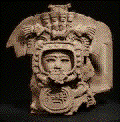 Her name is pronounced "shoke" in the old Mayan
language. The tongue spoken by 6 million Maya who still live in the area and an
estimated million who have moved to the United States still contains some of the
same words. Her name is pronounced "shoke" in the old Mayan
language. The tongue spoken by 6 million Maya who still live in the area and an
estimated million who have moved to the United States still contains some of the
same words.
Over the past 50 years, great strides have been made in reading the script of
the Maya, who have turned out to be inventive storytellers as well as effective
mathematicians and astronomers.
The Maya ball game became a religious ritual, symbolizing a struggle between
life and death. The ball could cause serious injury, and members of the losing
team sometimes were beheaded.
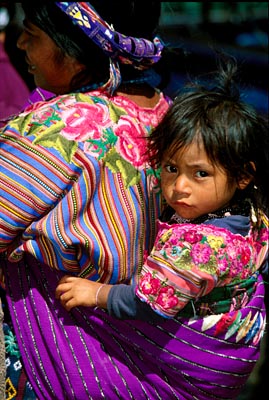 The Maya believed that even the young and
handsome Maize God, patron of their staple food, was beheaded every year in a
ball game at harvest time. He came back to life when the corn sprouted again. The Maya believed that even the young and
handsome Maize God, patron of their staple food, was beheaded every year in a
ball game at harvest time. He came back to life when the corn sprouted again.
Rules of the game are not clear, but it resembled soccer. Players, who could
not use their hands, operated in pairs, protected by what seems to have been
thick cotton quilting.
"They can easily be arranged to be in eternal play, the ball suspended in the
observer's mind for all time," says the catalog of the show.
Other figurines represent servants, dwarves, a trumpeter, a priest in
ornamental feathered costume, a messenger or possibly an ambassador in a bright
blue cloak and enormous hat.
Among the less ferocious figures are a grandmotherly Chak Chel, goddess of
weaving and childbirth, as nursemaid to a child who may be the young Maize God.
There also are huge cups for chocolate, one almost a foot high. A guide to
the show for children gives a recipe: unsweetened baking chocolate, water,
ground chili peppers and honey, if wanted.
King Pakal the Great reigned over Palenque. The ruins are an important
tourist attraction in the southern Mexican state of Chiapas, near the Guatemala
border.
Pakal and his sons built Palenque into an impressive city, one of at least 50
city-states, each with its own king.
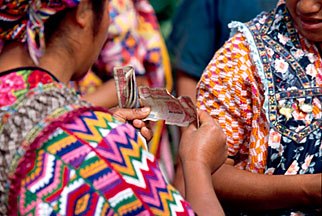 "Courtly Art of the Ancient Maya" will be on
show in the gallery's East Building through July 25 and from there will go to
the Fine Arts Museum of San Francisco, Sept. 4 to Jan. 2. "Courtly Art of the Ancient Maya" will be on
show in the gallery's East Building through July 25 and from there will go to
the Fine Arts Museum of San Francisco, Sept. 4 to Jan. 2.
In a double tribute to Mexico, the National Gallery also is opening on Sunday
a show devoted to one of the country's best known 20th century painters. "The
Cubist Paintings of Diego Rivera: Memory, Politics, Place" also will be seen
until July 25. From there it travels to the Museo de Arte Moderno in Mexico City
to go on show from Sept. 19 through Jan. 16. - Washington Post - Contributions
by ArtsyStuff Magazine |
